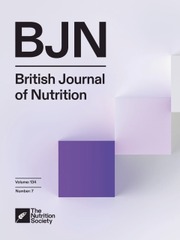No CrossRef data available.
Article contents
Associations between nutrition literacy and possible sarcopenia among older adults in Bengbu, China
Published online by Cambridge University Press: 04 November 2024
Abstract
To explore the associations between nutrition literacy (NL) and possible sarcopenia in older Chinese adults. A cross-sectional study was conducted. NL was assessed using a 12-item short-form NL scale. Possible sarcopenia was identified using SARC-CALF. Logistic regression was used to calculate odds ratios (ORs) and 95% confidence intervals (CIs) for NL and the incidence of possible sarcopenia. A total of 1,338 older individuals, aged 71.41 ± 6.84 years, were enrolled in this study. After confounders were adjusted for, older adults in the upper quartile of NL were found to be 52% less likely to have possible sarcopenia than those in the lower quartile of NL (OR = 0.48, 95% CI: 0.29–0.77). The associations between NL and possible sarcopenia were present only in those who lived in rural areas (OR: 0.38, 95% CI: 0.19–0.77), had a primary school education or less (OR: 0.21, 95% CI: 0.09–0.48), had a monthly income <3,000 RMB (OR: 0.39, 95% CI: 0.22–0.70), and had chronic diseases (OR: 0.37, 95% CI: 0.22–0.63). Moreover, an interaction effect was observed between having a chronic disease and junior high school education and being in the upper quartile of NL. The prevalence of possible sarcopenia in older Chinese adults is substantial, with prevalence decreasing with increasing NL. Moreover, the association between NL and possible sarcopenia varies by residence type, education level, monthly income, and chronic disease experience. Targeted NL interventions are required to prevent and manage sarcopenia in older adults, particularly those with low socioeconomic status and chronic diseases.
- Type
- Research Article
- Information
- Copyright
- © The Authors 2024


